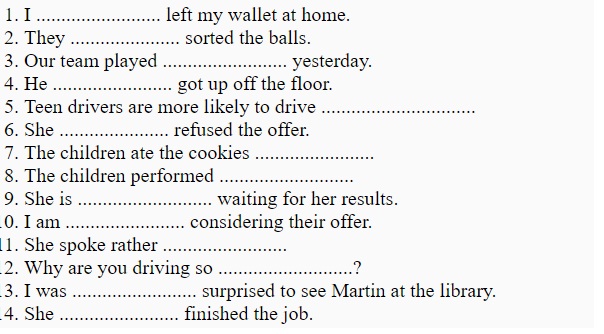Adverbs of Manner
Adverbs of manner say how something happens or is done. Examples are: cleverly, happily, anxiously, pleasantly etc.
Fill in the blanks with an appropriate manner adverb.
(pleasantly, angrily, eagerly, seriously, carefully, well, fast, slowly, recklessly, cleverly, stupidly, beautifully, politely, quickly)

Answers
1. I stupidly left my wallet at home.
2. They carefully sorted the balls.
3. Our team played well yesterday.
4. He slowly got up off the floor.
5. Teen drivers are more likely to drive recklessly.
6. She politely refused the offer.
7. The children ate the cookies greedily.
8. The children performed beautifully.
9. She is eagerly waiting for her results.
10. I am seriously considering their offer.
11. She spoke rather angrily.
12. Why are you driving so fast?
13. I was pleasantly surprised to see Martin at the library.
14. She quickly finished the job.
Worksheet 2
Complete each sentence given below using a word from the list. Sometimes you need the adjective and sometimes you need the adverb.
(anxious, nervous, perfect, quite, hard, incredible, vivid, large, genuine, quick)
1. I was ………………….. impressed by their performance.
2. We sold ……………………. any books yesterday.
3. Time passes ……………………. when you are on a holiday.
4. She shows ……………………. concern for the poor.
5. The children performed ……………………………. well.
6. It was an …………………….. performance.
7. She …………………….. narrated every detail.
8. She gave a …………………….. account of the incident.
9. These shoes are …………………… for me.
10. The coat fitted me ………………………….
11. I feel ……………………. before an exam.
12. She paced the floor …………………………
Answers
1. quite, 2. hardly, 3. quickly, 4. genuine, 5. incredibly, 6. incredible, 7. vividly, 8. vivid, 9. large, 10. perfectly, 11. nervous, 12. anxiously
See also